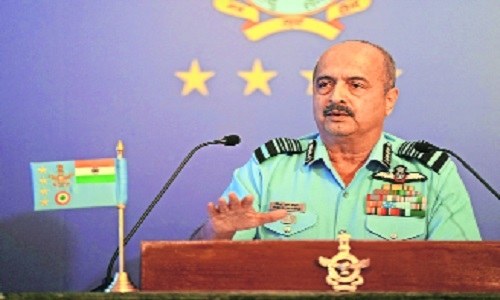‘IAF to replace all MiG-21 with LCA Mark 1A by 2025’
| Date :04-Oct-2023 |

NEW DELHI,
THE Indian Air Force is in the process of finalising a Rs 1.15 lakh crore deal to procure an additional batch of 97 Tejas Mark-1A aircraft besides upgrading 84 Sukhoi-30MKI jets at a cost of Rs 60,000 crore, Chief of Air Staff Air Chief Marshal V R Chaudhari said on Tuesday. He also noted that the IAF will replace all MiG-21 squadrons with the LCA Mark 1A by 2025.
In February 2021, the Defence Ministry sealed a Rs 48,000-crore deal with State-run aerospace major Hindustan Aeronautics Ltd for the procurement of 83 Tejas MK-1A jets for the IAF.
With the additional 97 Tejas Mark-1A jets, the total number of indigenously-developed aircraft being procured by the IAF would go up to 180. Addressing a press conference ahead of the Air Force Day on October 8, the Chief of Air Staff also said that 84 Sukhoi-30MKI fighter jets will be upgraded at a cost of a little over Rs 60,000 crore.
The Defence Ministry is also looking at signing a contract with the HAL next year to procure a total of 156 light combat helicopters (LCH) out of which 66 will be for the IAF. The IAF now operates 10 light combat helicopters. “We had signed the contract for 83 LCA-Mark 1As. What we are looking at is now to supplement that contract with 97 additional aircraft. “So it will bring the total to about 180 LCA-Mark-1As.
The contract value will be a little over 1.15 lakh crores,” Air Chief Marshal Chaudhari said.
‘Deployment along LAC to continue till there is complete disengagement’: THE IAF’s operational plans are very dynamic and it will deal with challenges along the Line of Actual Control (LAC) through better tactics and training in places where it cannot counter the
“numbers or the might of the adversary”, Air Chief Marshal V R Chaudhari said on Tuesday, amid the lingering border row with China in eastern Ladakh. The Chief of Air Staff, addressing a press conference ahead of the Air Force Day on October 8, asserted that the IAF will continue to remain deployed along the frontier in the region till complete disengagement takes place in the remaining contested areas.
“We make note of the build-up of resources and capabilities across the borders. Our operational plans are very dynamic and keep changing based on the situation that we perceive that is developing across any front,” he said.
“So in places where we cannot really counter the numbers or the might of the adversary, we will counter it through better tactics and through better training,” he said.
The Air Chief Marshal said the IAF does not have a fixed mindset in terms of the deployment of assets in key areas along the LAC.
“Our focus will remain to be dynamic at all times and not have a fixed mindset in terms of deployment of assets in particular areas. But we have very very flexible and dynamic war plans which we keep revising every now and then based on the ISR inputs that we get,” he said.
The Chief of Air Staff said the IAF is in the process of deploying mountain radars to improve surveillance along the borders.
“The situation continues to remain what it was in the last one year.
There have been disengagements in certain contested areas. But complete disengagement has not yet taken place,” he said when asked about the ground situation along the LAC in eastern Ladakh.
“We will continue to remain deployed till complete disengagement takes place,” he said.
Answering a question, Air Chief Marshal Chaudhari said that the IAF received three units of S-400 missile systems from Russia and it is hoping to receive the remaining two by next year.
The Chief of Air Staff described the Indo-Pacific region as the “new economic and strategic centre of gravity” of the world that offers both challenges and opportunities.
“The Indian Air Force with its inherent capability to see the farthest, reach the fastest and hit the hardest will be critical in mitigating these challenges and will remain a fulcrum in projecting India’s might in the region,” he said.
“Owing to the volatile and uncertain geopolitical landscape in our region, the need to have a strong and credible military has become an imperative,” he said.
The Chief of Air Staff said modern warfare is constantly undergoing a transformation due to rapid advancements in technology and that his force has embarked on a journey of transformation and is progressing in a planned and systematic manner.
“Our focus is on force multipliers in the form of AI (artificial intelligence)-based decision tools, electronic warfare equipment, robust networks and harnessing space and cyber capabilities.
“While adding newer and more potent equipment, platforms and weapons to our arsenal, we are also committed to Atmanirbhar Bharat and are contributing extensively towards enhancing indigenisation and defence production, fast-paced development and operationalisation of indigenous aerospace projects,” he said.
Air Chief Marshal Chaudhari said persistent surveillance capability, sharpening of sensor-to-shooter time, long-range precision weapons and development of multi-domain capability are the main focus areas of the IAF.
“We have recently witnessed the induction of the first C-295 aircraft. The project is an important milestone in boosting our defence industry and will contribute immensely,” he said.